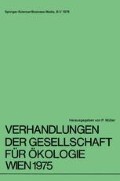Abstract
Haline inland biotops show much greater instability in nearly all factors compared with marine or brackish habitats. Physiological adaptation is vital, as an impermeable membrance can only reduce osmotical stress. Exchange of water and ions takes place either in form of diffusion or as active transport. While diffusion is dependent on a positive gradient, active transport is mostly restricted to certain cells or epithelia and works against the concentration gradient. The concentration of the medium determines the size of active epithelia. Ionic composition of the medium is the second important factor in addition to concentration. All biological functions are influenced by this two dominants. Landarthropodes are seemingly less influenced by salt in the environment, complicated behavior helps to avoid salt or the animals accept the haline biotopes for other, secondary reasons. Further investigations are necessary.
Access this chapter
Tax calculation will be finalised at checkout
Purchases are for personal use only
Preview
Unable to display preview. Download preview PDF.
Literatur
BRO LARSEN, E. (1952): On subsocial beetles from the salt-marsh, their care of progeny and adaption to salt and tide. Trans. 9. Int. Congr. Ent. 1: 502–506.
CURRAN, P.F. and MACINTOSH, J.R. (1962): A model system for biological water transport. Nature 193: 347–348.
DIAMOND, J.M. (1971): Water-solute coupling and ion selectivity in epithelia. Phil. Trans. Roy. Soc. London B 262: 141–151.
HOCHACHKA, P.W. and SOMERO, G.N. (1973) Strategies of biochemical adaptation. W.B. Saunders Co., Philadelphia — London — Toronto, 358 S.
IMHOF, G. (1973): Der Einfluß von Temperatur und Photoperiode auf den Lebenszyklus einiger Süßwasser-Pulmonaten. Malacologia 14: 393–395.
KLEKOWSKI, R.Z. (1961a): Die Resistenz gegen Austrocknung bei einigen Wirbellosen aus asiatischen Gewässern. Verh. Internat. Verein. Limnol. 14: 1023–1028.
KLEKOWSKI, R.Z. (1961b): Survival of Planorbis planorbis (L.) and other snails in diluted sea water and during the following desiccation. Polsk. Arch. Hydrobiol. 9 (22): 383–406.
KLEKOWSKI, R.Z. (1963): Water balance and osmoregulation in the snail Coretus corneus (L.) under conditions of desiccation and in diluted sea water. Polsk. Arch. Hydrobiol. 11 (24): 219–240.
KNÜLLE, W. (1953): Zur Ökologie der Spinnen an Ufern und Küsten. Z. Morph. Okol. Tiere 42: 117–158.
KÖFLER, D. (1975): Zur Faunistik und Ökologie der Wassermilben des Neusiedlersee-Gebietes. Diss., Phil. Fak. Graz.
LAGERSPETZ, K. (1958): The brackish-water tolerance of some freshwater crustaceans. Verh. Internat. Verein. Limnol. 13: 718–721.
NEMENZ, H. (1969): Ökologische und physiologische Untersuchungen an einem Hydrophiliden hyperhaliner Gewässer, (Bero sus spinosus). Vie et Milieu 20, Ser C: 171–230.
NEMENZ, H. (1970): lonenverhältnisse und die Besiedlung hyperhaliner Gewässer, besonders durch Insekten. Ein Beitrag zum Rapie-Problem. Acta Biotheoretica 19: 148–170.
NEMENZ, H. (1971): Physiologische Probleme der Osmoregulation in Binnenlandsalzgewässern. (Abh. Natrongewässer-Symposium Tihany — Szeged — Szarvas, (29.9 —4.10. 1969 ), Sitzber. Ost. Akad. Wiss. Math. natw. Kl., Abt. I, 179: 269–278.
NEMENZ, H. (1972): Der Einfluß der Ionenmilieus auf das Überleben von Planorbis planorbis und Planorbis corneus. Verh. D. Zool. Ges. 65: 172–176.
NEUMANN, D. (1961): Osmotische Resistenz und Osmoregulation aquatischer Chironomidenlarven. Biol. Zentralbl. 80: 693–715.
PORA, E.A. (1958): Considerations sur l’equilibre ionique chez les animaux. L’homéorapie. J. Physiologie 50: 462–464.
PORA, E.A. (1959): Considerations sur la faculté qu’ont les animaux de maintenir dans leur organisme un raport constant entre les ions à action antagoniste. Rapie et Homéorapie (rum., fr. Zusf.) Festschrift Tr. Savulescu Acad. Rep. Pop. Romine: 633–640.
PORA, E.A. (1962): Considerations sur l’importance du facteur osmotique et du facteur rapique dans le developpement de la vie dans la Mer Noire. Acta Biotheoretica 15: 161–174.
PORA, A.E. (1969): L’importance du facteur rhopique (èquilibre ionique) pour la vie aquatique. Verh. Internat. Verein. Limnol. 17: 970–986.
PORA, A.E. (1973): Le facteur rhopique en biologie marine. Archo. Oceanogr. Limnol. 18: (1973): 63–93.
RUTTNER-KOLISKO, A. (1971): Rotatorien als Indikatoren für den Chemismus von Binnensalzgewässern. Sitzber. Ost. Akad. Wiss. Math. natw. Kf, Abt. I, 179: 283–298.
SCHIEMER, E. (1965): Uber einige Funde der Gattung Monhystrella (Nematoda, Monhysterinae) in binnenländischen athalassohalinen Salzgewässern. Wiss. Arb. Burgenland 34: 59–66.
SCHOFFENIELS, E. (1961/62): Différentiation cellulaire et caractères de perméabilité. Ann. Soc. R. Zool. Belg. 92: 195–198.
SCHOFFENIELS, E. and BACQ, Z.M. (1963): Les équilibres catoniques. Handbuch experim. Pharmakologie, Erg. Werk XVIII /1: 492–515.
SCHROETER, H. (1924): Das Tote Meer. Wien-Leipzig, M. Perles, 74 S.
STRENZKE, K. and NEUMANN, D. (1960): Die Variabilität der abdominalen Körperanhänge aquatischer Chironomidenlarven in Abhängigkeit von der Ionenzusammensetzung des Mediums. Biol. Zentralbl. 79: 199–225.
WICHARD (1975): Zur osmoregulatorischen Anpassung von Wasserinsekten im Neusiedler-see Gebiet. Nachr. Bl. Bayr. Ent. (im Druck).
WICHARD, W. and SCHMITZ, M. (1974): Der histochemische Nachweis von Schwermetallen in den Chloridzellen aquatischer Insekten als Indikator für die Gewässerbelastung. Verh. Ges. Ökologie, Erlangen: 155–159.
ZIEMANN, H. (1970): Zur Gültigkeit des Saprobiensystems in versalzten Binnengewässern. Limn. 7: 279–293.
ZIEMANN, H. (1973): Untersuchungen über den Einfluß verdünnter Kaliendlaugen auf den Abbau organischer Substanzen im Wasser. Acta hydrochim. hydrobiol. 1: 257–265.
Author information
Authors and Affiliations
Editor information
Editors and Affiliations
Rights and permissions
Copyright information
© 1976 Springer Science+Business Media Dordrecht
About this chapter
Cite this chapter
Nemenz, H. (1976). Physiologische Anpassungen an Salzstandorte bei Land- und Wassertieren des Binnenlandes. In: Müller, P. (eds) Verhandlungen der Gesellschaft für Ökologie Wien 1975. Springer, Dordrecht. https://doi.org/10.1007/978-94-015-7168-5_31
Download citation
DOI: https://doi.org/10.1007/978-94-015-7168-5_31
Publisher Name: Springer, Dordrecht
Print ISBN: 978-94-015-7170-8
Online ISBN: 978-94-015-7168-5
eBook Packages: Springer Book Archive

